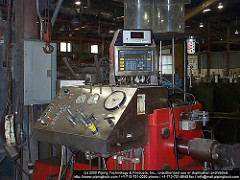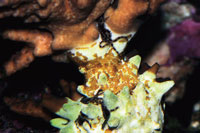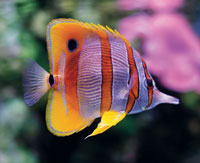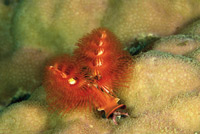
Q. I have a 55-gallon reef aquarium with a wet-dry filter and undergravel filter, a wavemaker with two powerheads and two very high output fluorescent lights — one white, one blue (both one month old). The aquarium temperature is 75 degrees Fahrenheit. I add calcium, iodine, strontium and invertebrate smorgasbord weekly, as designated on the bottles. I do monthly 10- to 15-percent water changes, and add Biozyme and Marine Buffer at that time.
The aquarium contains approximately 2 inches of crushed coral, live rock, one Sebae anemone, one mystery anemone, three types of mushroom anemonew, a small colony of yellow button polyps, one plate coral, a gorgonian (I believe) and another type of soft coral and two rapidly decreasing star polyp rocks (due to hair algae). I also have one each maroon clownfish, mandarin fish and convict goby, and a few turbo snails.
As of today, the pH is 8.4 to 8.6, 0 nitrates, 0 nitrite and 0.25 ppm ammonia — possibly due to a fish death. I will do a water change and things should be back to normal. My aquarium has been set up for three years.
I have a problem with my corals not retaining their color — almost everything turns to eraser pink. I was told to get strong lighting, but still no change. I have had the lighting system for one year. Is there something I'm not adding or doing or am I destined to have a pink aquarium?
Next, what do I do about hair, red slime and green algae? They have caused the death of the star polyps and almost a bubble coral. I have found one thing that works, but am unsure as to whether it is safe for continued use. A phosphate filter, along with a red and hair algae additive, works wonders. The first time I used it there were no visible effects on my coral. I'm curious though — once the algae is gone can I still use the sponge filter regularly to keep phosphates low?
I tried sea urchins (they don't seem to live long) and turbo snails, but something else in the aquarium ends up dining on them. I'm on a limited budget, but anything you can suggest would be appreciated.
A. Wow, lots to discuss in this letter. Your system is overloaded with respect to nutrients. You have a trickle filter that adds nitrates to the system. You have an undergravel filter with 2 inches of crushed coral that I am sure you have not hydrovaccumed for some time — this also adds nitrates and probably harbors a significant amount of detritus and phosphate. You don't use a protein skimmer. You don't mention if you use activated carbon, some of which can leach phosphate. And you add liquid invertebrate foods and other additives you don't really need. You don't mention it, but I assume you are using tap water for top-offs and for making your seawater.
So, the way I see it, you are adding lots of nutrients, but, aside from a monthly water change, you are not removing any. That is why you have seen an improvement with the phosphate sponge — there are excess nutrients, such as phosphate, in your system.
It does not harm the system to use the phosphate sponge continuously. However, you should stop and ask yourself: what is causing these algae to proliferate in the first place? Removing the symptom by reducing nutrient levels does work, but it doesn't solve the cause of the problem. You need to deal with the reasons for the algae growth.
The first thing I would recommend you do is get an efficient protein skimmer that can turn over the entire volume of your aquarium at least twice an hour. I would then remove the biomedia from your trickle filter.
As for the undergravel filter, you should vaccum the substrate at least weekly to start to keep detritus from accumulating in it. Later you could probably get away with doing it once a month or so when you do your water change. Better yet, I would remove the entire thing if you can.
Stop using the liquid invertebrate food. The corals you have probably don't need it, and it only adds to the nutrient load in the system. I would also stop using the Biozyme. You shouldn't need it. I would switch over to using calcium hydroxide solution to maintain the calcium and alkalinity levels instead of the calcium and buffer combo you are using now. It will also help to precipitate phosphate from the water. You should be measuring the calcium, pH and alkalinity on a frequent basis. You only mentioned the pH level, which makes me wonder what the calcium and alkalinity are — low, I'm willing to bet.
Finally, I would look at your freshwater source. Does it contain phosphate, nitrate, iron, silicate? These are all potential nutrient sources for algal growth. You may need to switch to using a reverse osmosis or deionization unit to ensure nutrient-free freshwater.
If you do all these things, chances are you will see a rapid improvement in your system. By using additional algae grazers, such as small hermit crabs and tangs, you will prevent the algae from spreading throughout your system again.
Once you have your water quality and the undesirable algae under control, you will most likely see an improvement in the colors of your corals. I would also examine the iodide supplement you are using. Does it adequately replenish the iodide in your system with the dosage it recommends? One way to ascertain this would be to get an iodide test kit and see what the levels in your aquarium are.
 Would You Like The Supreme Fishing Experience? Heres The Reason Why It Is Essential To Carry The Mo
If what youre seeking out is considerably more fish thr
Would You Like The Supreme Fishing Experience? Heres The Reason Why It Is Essential To Carry The Mo
If what youre seeking out is considerably more fish thr
 Red Worms
Q. I’ve seen advertisements for red worms as a food for fish
Red Worms
Q. I’ve seen advertisements for red worms as a food for fish
 Coral and Invertebrate Quarantine Procedures
Coral and Invertebrate Quarantine Procedures
 Aiptasia Anemone
Aiptasia Anemone
 Aiptasia
Q. I have Aiptasia all over my aquarium and have been
Aiptasia
Q. I have Aiptasia all over my aquarium and have been
Copyright © 2005-2016 Pet Information All Rights Reserved
Contact us: www162date@outlook.com